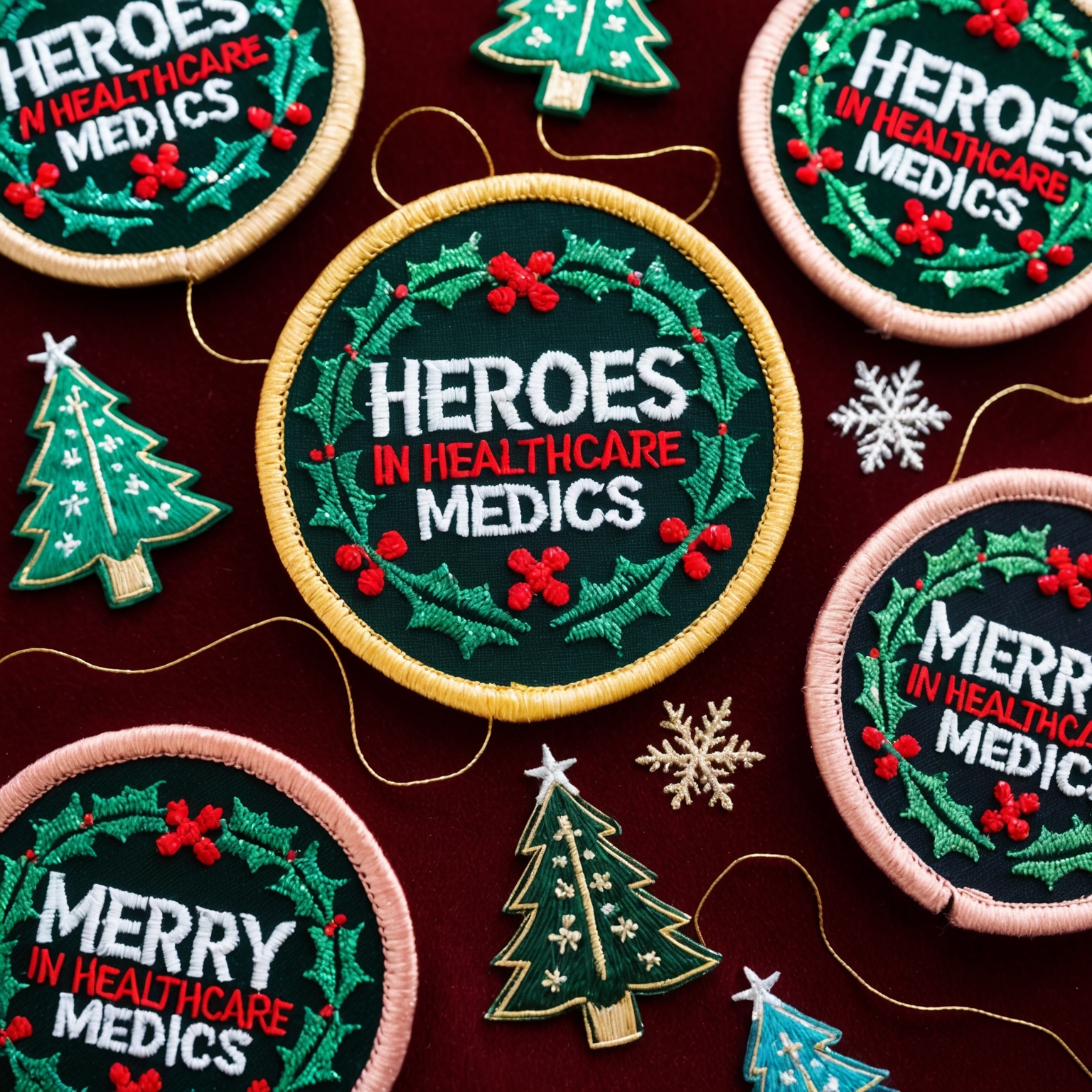Emergency Medical Services (EMS) play a critical role in public health and safety, providing life-saving care to those in need. Over the years, the field of EMS has evolved significantly, both in terms of medical practices and the symbols that represent this vital service. One of the most iconic and recognizable symbols in EMS is the EMS patch. These patches, often worn on the uniforms of paramedics, emergency medical technicians (EMTs), and other EMS professionals, have a rich history that reflects the evolution of the EMS profession itself.
EMS patches are more than just uniform accessories; they serve as badges of honor, symbols of authority, and representations of the dedication and expertise required in emergency medical care. As EMS has developed into a specialized and highly respected field, the design and significance of EMS patches have also evolved, reflecting changes in medical standards, professional recognition, and organizational identity.
In this article, we will explore the evolutionary journey of EMS patches, tracing their origins, the factors that influenced their design, and their role in establishing the identity and recognition of EMS professionals. We will also discuss how EMS patches have adapted to the changing landscape of emergency medical services and their ongoing importance in the profession today.
The Origins of EMS Patches
The history of EMS patches is closely intertwined with the development of emergency medical services as a formalized profession. To understand the origins of EMS patches, it is important to first look at the early days of emergency medical care and how the need for a recognizable symbol of authority and professionalism emerged.
1. Early Days of Emergency Medical Care
Before the establishment of modern EMS systems, emergency medical care was often provided by a variety of individuals and organizations, including firefighters, police officers, and even volunteers. These early responders had little formal medical training, and there was no standardized system for providing emergency care. As a result, the quality and consistency of care varied widely, and there was little recognition of emergency medical services as a distinct profession.
In the mid-20th century, the need for a more organized and professional approach to emergency medical care became increasingly apparent. Advances in medical technology, along with growing public awareness of the importance of timely and effective emergency care, led to the development of the first formal EMS systems in the United States and other countries.
2. The Birth of EMS and the Need for Identification
As EMS began to take shape as a distinct field, there was a growing need for a way to identify and recognize EMS professionals. The development of standardized EMS uniforms was one of the first steps in this process. Uniforms helped to establish the authority and professionalism of EMS providers, making it clear to the public that these individuals were trained and equipped to provide emergency care.
EMS patches soon became an integral part of these uniforms. The patches served as visual identifiers that conveyed important information about the wearer’s role, training, and affiliation with a particular EMS organization or service. Early EMS patches were often simple in design, featuring basic symbols such as the Red Cross or the Star of Life, along with the name of the EMS provider or organization.
3. The Evolution of EMS Patches
Over time, EMS patches became more elaborate and sophisticated, reflecting the growing complexity and professionalism of the EMS field. As EMS systems expanded and specialized, patches began to incorporate additional elements, such as state or regional symbols, unit designations, and references to specific areas of expertise, such as paramedics or advanced life support (ALS).
The evolution of EMS patches was also influenced by broader trends in uniform design and military insignia. Many early EMS patches were inspired by military patches, borrowing elements such as shield shapes, banners, and heraldic symbols. This connection to military tradition helped to further establish EMS as a respected and disciplined profession.
The Design and Symbolism of EMS Patches
EMS patches are rich in symbolism, with each element of the design serving a specific purpose or conveying a particular message. The design of an EMS patch can provide insight into the history, values, and mission of the EMS organization it represents. In this section, we will explore some of the key design elements commonly found in EMS patches and their significance.
1. The Star of Life
One of the most iconic symbols in EMS is the Star of Life. This six-pointed star, typically blue in color, is universally recognized as a symbol of emergency medical services. The Star of Life is often the central element of EMS patches, serving as a powerful representation of the life-saving work performed by EMS professionals.
The Meaning of the Star of Life:
- Six Points: The six points of the Star of Life represent the six stages of emergency medical care: Detection, Reporting, Response, On-Scene Care, Care in Transit, and Transfer to Definitive Care.
- Rod of Asclepius: At the center of the Star of Life is the Rod of Asclepius, a symbol of medicine and healing. The rod, encircled by a serpent, is an ancient symbol associated with the Greek god Asclepius, who was revered for his healing powers.
- Color: The blue color of the Star of Life is often associated with trust, professionalism, and calmness—qualities that are essential in emergency medical care.
2. State and Regional Symbols
Many EMS patches include symbols that represent the state or region in which the EMS provider operates. These symbols can vary widely, from state flags and seals to iconic landmarks and regional flora or fauna. Incorporating state and regional symbols into EMS patches helps to establish a sense of local identity and pride, while also conveying the geographical area served by the EMS provider.
Examples of State and Regional Symbols:
- State Flags: Some EMS patches feature the state flag or elements of the state flag, such as the Lone Star for Texas or the bear for California.
- Local Landmarks: Patches may include depictions of well-known landmarks, such as mountains, bridges, or monuments that are iconic to the region.
- Regional Wildlife: EMS patches might also incorporate images of animals or plants that are native to the area, such as the bald eagle for the United States or the maple leaf for Canada.
3. Unit and Division Insignia
As EMS systems became more specialized, patches began to include unit and division insignia that identified the specific role or area of expertise of the wearer. These insignia help to distinguish between different levels of training, such as EMT-Basic, EMT-Intermediate, or Paramedic, as well as different divisions within an EMS organization, such as ambulance services, air medical services, or specialized rescue teams.
Common Unit and Division Insignia:
- EMT and Paramedic Insignia: Many EMS patches include specific insignia or text that identifies the wearer as an EMT or Paramedic, often accompanied by the Star of Life or other medical symbols.
- Rescue and Special Operations: Specialized EMS units, such as rescue teams or hazardous materials (HAZMAT) units, may have their own unique patches that reflect their specific training and mission.
- Air Medical Services: EMS patches for air medical services, such as helicopter or fixed-wing transport teams, often feature aviation symbols, such as wings or aircraft silhouettes.
4. Colors and Shapes
The colors and shapes used in EMS patches are carefully chosen to convey specific meanings and create a cohesive visual identity. While the Star of Life is typically blue, the overall color scheme of an EMS patch can vary widely depending on the organization and its branding.
Color Symbolism in EMS Patches:
- Blue: As mentioned earlier, blue is a common color in EMS patches, representing trust, professionalism, and calmness. It is also the color of the Star of Life.
- Red: Red is often associated with urgency, action, and medical care, making it a popular choice for EMS patches that emphasize the life-saving nature of the work.
- Gold and Silver: Gold and silver are often used to represent excellence, honor, and achievement. These colors are commonly found in patches that recognize advanced training, certifications, or awards.
Common Patch Shapes:
- Shield: The shield shape is one of the most common shapes for EMS patches, evoking a sense of protection, authority, and tradition.
- Circular: Circular patches are often used for their simplicity and versatility, providing a balanced and symmetrical design that is easy to apply to uniforms.
- Custom Shapes: Some EMS patches are designed in custom shapes that reflect the organization’s unique identity or mission, such as the outline of a state or a specific medical symbol.
The Role of EMS Patches in Professional Recognition
EMS patches serve as more than just visual identifiers; they are also symbols of professional recognition and achievement. The journey to becoming an EMS professional requires extensive training, certification, and dedication, and EMS patches help to recognize and honor these accomplishments.
1. Recognition of Training and Certification
One of the primary functions of EMS patches is to recognize the training and certification levels of EMS professionals. Patches can indicate the wearer’s qualifications, such as Basic Life Support (BLS), Advanced Life Support (ALS), or specialized certifications in areas like pediatric care or trauma management.
Examples of Training and Certification Patches:
- BLS and ALS Patches: EMS professionals who have completed Basic Life Support or Advanced Life Support training may wear patches that indicate their certification level, often accompanied by the Star of Life.
- Specialty Certifications: Patches may also recognize specialty certifications, such as Pediatric Advanced Life Support (PALS) or Prehospital Trauma Life Support (PHTLS), highlighting the wearer’s expertise in specific areas of emergency care.
- Instructor Patches: EMS professionals who serve as instructors or trainers may wear patches that designate their role, often featuring the word “Instructor” or a similar designation.
2. Awards and Commendations
EMS patches are also used to recognize outstanding performance, bravery, and dedication in the field. These award patches serve as a visible reminder of the wearer’s achievements and contributions to the EMS profession.
Examples of Award and Commendation Patches:
- Valor Patches: EMS professionals who have demonstrated exceptional bravery or heroism in the line of duty may be awarded valor patches, often featuring symbols such as stars, eagles, or laurel wreaths.
- Service Awards: Long-serving EMS professionals may receive patches that recognize their years of service, such as “10 Years of Service” or “20 Years of Service” patches.
- Unit Citations: EMS teams that have performed exceptionally well in a specific mission or operation may receive unit citation patches, recognizing their collective efforts and success.
3. Building Professional Identity and Pride
Wearing EMS patches is a source of pride for many EMS professionals, as these patches symbolize their hard-earned qualifications, commitment to public service, and dedication to saving lives. The patches help to build a strong professional identity, fostering a sense of belonging and camaraderie within the EMS community.
The Impact of Patches on Professional Identity:
- Cohesion: EMS patches help to create a sense of cohesion among team members, reinforcing the idea that they are part of a larger, dedicated group of professionals working towards a common goal.
- Recognition: The visibility of EMS patches in public settings, such as during emergency responses, helps to establish the authority and credibility of EMS professionals, ensuring that they are recognized and respected by the public.
- Motivation: The recognition and symbolism associated with EMS patches can serve as a motivating factor for EMS professionals, inspiring them to continue their education, pursue advanced certifications, and strive for excellence in their work.
The Evolution of EMS Patches in Response to Changing Needs
As the field of emergency medical services continues to evolve, so too do the design and use of EMS patches. Advances in medical technology, changes in public health priorities, and the increasing complexity of EMS roles have all contributed to the ongoing evolution of EMS patches.
1. Adapting to New Medical Standards
The development of new medical standards and protocols has led to the creation of specialized EMS patches that reflect the latest advancements in emergency care. For example, as new treatments and techniques are introduced, EMS patches may be updated to include symbols or text that represent these innovations.
Examples of Adaptations:
- New Certifications: As new certifications are developed, such as those related to advanced airway management or critical care transport, EMS patches are created to recognize these specialized skills.
- Updated Protocols: Patches may also be updated to reflect changes in medical protocols or the introduction of new equipment, ensuring that EMS professionals are recognized for their ability to stay current with the latest practices.
2. Responding to Public Health Crises
Public health crises, such as the COVID-19 pandemic, have had a significant impact on the EMS profession, leading to the development of new EMS patches that recognize the unique challenges faced by EMS professionals during these times.
Examples of Crisis-Related Patches:
- Pandemic Response Patches: EMS patches that recognize the efforts of EMS professionals during the COVID-19 pandemic may include symbols such as face masks, viruses, or phrases like “Frontline Hero” or “COVID-19 Response.”
- Disaster Response Patches: In the wake of natural disasters or other large-scale emergencies, EMS patches may be created to recognize the contributions of EMS teams who provided critical care and support to affected communities.
3. Embracing Diversity and Inclusion
As the EMS profession becomes more diverse, there is a growing recognition of the importance of creating inclusive EMS patches that reflect the diversity of the EMS workforce and the communities they serve. This includes the development of patches that celebrate cultural heritage, gender diversity, and other aspects of identity.
Examples of Inclusive Patches:
- Cultural Heritage Patches: EMS patches that incorporate symbols or designs related to specific cultural or ethnic backgrounds help to celebrate the diversity of the EMS workforce and the communities they serve.
- Pride Patches: EMS patches that feature LGBTQ+ symbols, such as the rainbow flag, demonstrate a commitment to inclusivity and support for LGBTQ+ EMS professionals.
- Gender-Inclusive Patches: Some EMS patches are designed to be gender-neutral or to celebrate the achievements of women and other underrepresented groups in the EMS profession.
The Ongoing Importance of EMS Patches
As we have seen, EMS patches have played a significant role in the evolution of the EMS profession, serving as symbols of authority, recognition, and pride. As the field of EMS continues to evolve, EMS patches will remain an important part of the professional identity and recognition of EMS professionals.
1. Maintaining Tradition and Heritage
EMS patches are deeply rooted in tradition, reflecting the history and heritage of the EMS profession. As new generations of EMS professionals enter the field, the continuation of these traditions through EMS patches helps to maintain a sense of continuity and connection to the past.
2. Adapting to Future Challenges
As the EMS profession faces new challenges, such as the increasing complexity of medical care and the growing demands of public health, EMS patches will continue to evolve to reflect these changes. This adaptability ensures that EMS patches remain relevant and meaningful symbols of the profession.
3. Promoting Professional Excellence
The ongoing use of EMS patches as symbols of recognition and achievement helps to promote a culture of professional excellence within the EMS community. By recognizing the hard work, dedication, and expertise of EMS professionals, these patches encourage continuous learning, growth, and improvement in the field.
The Evolutionary Journey of EMS Patches
The journey of EMS patches from their early beginnings to their current status as symbols of professional recognition and pride is a testament to the evolution of the EMS profession itself. These patches have not only served as visual identifiers but have also played a crucial role in establishing the identity, authority, and credibility of EMS professionals.
As the field of emergency medical services continues to evolve, EMS patches will remain a vital part of the profession, reflecting the changing landscape of EMS and the ongoing commitment of its professionals to saving lives and serving their communities. Whether worn on the uniforms of paramedics, EMTs, or specialized rescue teams, EMS patches stand as a proud reminder of the dedication, expertise, and heroism that define the EMS profession.
If you are interested in purchasing high-quality custom patches, feel free to call us at 1-866-903-4903 or fill out one of our FREE quotes here.




